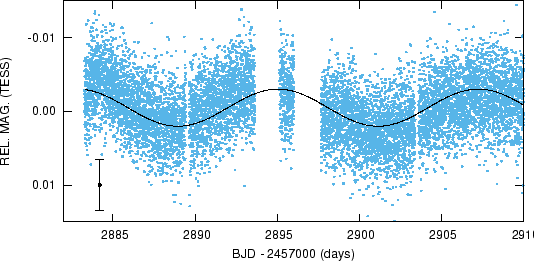|
Peremennye Zvezdy (Variable Stars) 45, No. 3, 2025 Received 3 January; accepted 24 January. |
Article in PDF |
|
DOI: 10.24412/2221-0474-2025-45-32-44
|
Photometric Study of New and Suspected Binary Stars in the Fields of V0873 Per and CV Boo
A.V.Khalikova1, E.R. Gaynullina1, A.V. Serebryanskiy2, B.L. Satovskiy3
- Ulugh Beg
Astronomical Institute, Uzbek Academy of Sciences,
Astronomicheskaya Str. 33, 100072, Tashkent, Uzbekistan; e-mails:
ahalikova@astrin.uz, evelina@astrin.uz
- Fesenkov
Astrophysical Institute, Observatory 23, 050020, Almaty,
Kazakhstan; e-mail: alex@aphi.kz
- State Space Corporation "Roscosmos", Moscow, Russia
|
Six binary and candidate binary stars in the fields of
V0873 Per and CV Boo were found using archive observations of the
Mt. Maidanak Astronomical Observatory. (1) 2MASS J02465266+4125290
is a detached eclipsing binary with the period of
|
1. Introduction
Several known eclipsing binaries have been observed at Mt. Maidanak Astronomical Observatory (MAO) in Uzbekistan. In 2013 and 2014, the observations were carried out in the frame of the SPAREBIS (Search for Planets Around Eclipsing Binary Stars) project initiated by Tutukov & Bogomazov (2012). Some stars were additionally observed in 2015. The field of V0873 Per was observed in 2013, 2014, and 2015 (45 nights in total). Several stars have been suspected of being variable during data processing and analysis, which included machine learning methods. As a result, we have been able to confirm five variable stars. CV Boo was observed during 41 nights in May-July, 2014. After cross-identification of stars around CV Boo with catalogs of suspected variable stars, we confirmed variability for one of our discoveries. The paper presents the results of our study of those objects that we classified as binary or candidate binary stars. In Section 2, we describe the observations and data processing. In Section 3, we describe data analysis and our results. The conclusions are summarized in Section 4.
2. Observations and data reduction
The field of V0873 Per was observed during 22 nights in 2013, 7
nights in 2014, and 16 nights in 2015. All observations were
carried out using the 60 cm Zeiss-600 North telescope with the
focal length of 7200 mm, equipped with an FLI MicroLine CCD, with
a Kodak KAF-1001E chip. The scale was
![]() per pixel,
providing the field of view (FoV) of
per pixel,
providing the field of view (FoV) of
![]() .
The observations were performed in the Bessel
.
The observations were performed in the Bessel ![]() filter. The
typical exposure times were 25-40 seconds. The average Full Width
at Half Maximum (FWHM) in each observing season was
filter. The
typical exposure times were 25-40 seconds. The average Full Width
at Half Maximum (FWHM) in each observing season was
![]() ,
,
![]() ,
,
![]() for 2013, 2014, and 2015, respectively.
The number of stars measured each night was from 120 to 230
depending on the specific sky area in the telescope FoV. We
calculated differential magnitudes using the same comparison stars
as in Bogomazov et al. (2016a), TYC 2853 294-1 and TYC 2853-312-1
(R1 and R2, see Table 1) for different nights. The star
TYC 2853-744-1 (S1) was used as a check star. These three stars
are assumed to be non-variable during our observations.
for 2013, 2014, and 2015, respectively.
The number of stars measured each night was from 120 to 230
depending on the specific sky area in the telescope FoV. We
calculated differential magnitudes using the same comparison stars
as in Bogomazov et al. (2016a), TYC 2853 294-1 and TYC 2853-312-1
(R1 and R2, see Table 1) for different nights. The star
TYC 2853-744-1 (S1) was used as a check star. These three stars
are assumed to be non-variable during our observations.
The observations of the field of CV Boo were carried out during 34
nights in 2014 using the 51 cm AMT-1 telescope (AstroTel Ltd.)
with the focal length of 4000 mm, equipped with Apogee Alta-U16M
4K![]() 4K CCD, the light detector being a Kodak KAF-1001E chip.
The scale was
4K CCD, the light detector being a Kodak KAF-1001E chip.
The scale was
![]() per pixel, and the FoV was
per pixel, and the FoV was
![]() . Observations were performed in the
Bessel
. Observations were performed in the
Bessel ![]() filter. The typical exposure times were 8-20 seconds.
The average FWHM was
filter. The typical exposure times were 8-20 seconds.
The average FWHM was
![]() . We selected BD +37 2645 (R3) as
the comparison star and TYC 2570-417-1 (S2) as the check star
(Bogomazov et al. 2016b).
. We selected BD +37 2645 (R3) as
the comparison star and TYC 2570-417-1 (S2) as the check star
(Bogomazov et al. 2016b).
Basic image reductions (dark current and flat field corrections) were performed for both fields using standard IRAF1 software. We applied differential photometry with the IRAF/DAOPHOT package. For uncertainties of instrumental magnitudes, we accepted the standard IRAF errors. No differential extinction corrections were applied.
Basic information for the comparison and check stars is provided
in Table 1. The coordinates are given according to the GAIA DR3
catalog (Gaia Collaboration et al. 2021); ![]() magnitudes and
magnitudes and ![]() color indices are from the AAVSO Photometric All Sky Survey
(Henden et al. 2015).
color indices are from the AAVSO Photometric All Sky Survey
(Henden et al. 2015).
| Stars | ID | ||||
| [h:m:s] | [ |
[mag] | [mag] | ||
| V0873 Per field | |||||
| R1 | TYC 2853-294-1 | 02:47:18.02 | +41:23:07.4 | 10.97 (0.03) | 0.94 (0.04) |
| R2 | TYC 2853-312-1 | 02:47:08.41 | +41:20:49.7 | 11.27 (0.02) | 0.37 (0.03) |
| S1 | TYC 2853-744-1 | 02:47:21.96 | +41:23:08.2 | 12.08 (0.02) | 1.25 (0.04) |
| CV Boo field | |||||
| R3 | BD +37 2645 | 15:27:06.86 | +36:59:27.0 | 10.68 (0.10) | 0.57 (0.11) |
| S2 | TYC 2570-417-1 | 15:27:28.79 | +36:47:22.5 | 11.08 (0.09) | 1.07 (0.11) |
3. Light curve analysis and results
3.1. The field of V0873 Per
The light curves were analyzed for variability using unsupervised clusterization methods. For photometric observations, especially for large-scale surveys, the same unsupervised machine learning model is an easy way to perform many different tasks (preliminary classification, selection of anomalies, dimension reduction, discovering hidden patterns in data), in variance to supervised machine learning model that is trained for a single specific task. We performed cluster analysis using our new light curve representation (Khalikova et al. 2022). We assumed that the clusters with one or two light curves (the so-called anomaly clusters) contain the light curves of stars that may be variable because their behavior differs from the bulk of the sample. After visual examination of the smallest clusters, we discovered that, indeed, some stars were possibly variable. In particular, one of the stars turned out to be a detached binary star. Additionally, we cross-matched the stars in the field slightly larger than the telescope FoV with ATLAS (Heinze et al. 2018) and ZTF (Chen et al. 2020) catalogs of suspected variable stars and also extracted the publicly available light curves (sector 58) from TESS mission (Stassun et al. 2019). As a result, we selected several stars for further analysis as candidate binary stars.
3.1.1. Star a: 2MASS J02465266+4125290
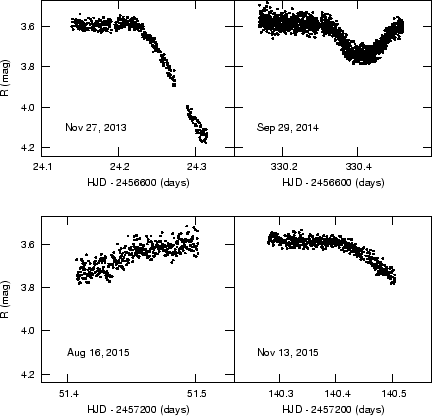 |
Fig. 1. The light curves of the star 2MASS J02465266+412590 (the star a) during 4 nights (MAO) showing variability. |
The star a (
![]() , J2000)
is a member of the open star cluster NGC 1039
(Cantat-Gaudin et al. 2018). It was classified in the ATLAS
catalog as "dubious", with the periods from long-period Fourier
and Lomb-Scargle fit being
, J2000)
is a member of the open star cluster NGC 1039
(Cantat-Gaudin et al. 2018). It was classified in the ATLAS
catalog as "dubious", with the periods from long-period Fourier
and Lomb-Scargle fit being
![]() and
and
![]() , respectively. According to Maíz Apellániz
et al. (2023), this star has a variability flag VARF="variable"
but without classification. The light curves of this star from
four MAO observing nights show that it is a detached eclipsing
binary. These differential light curves are shown in Fig. 1. In
the top left panel (November 27, 2013), we see a part of the
primary eclipse; the other 3 nights demonstrate a secondary
eclipse or a part of it.
, respectively. According to Maíz Apellániz
et al. (2023), this star has a variability flag VARF="variable"
but without classification. The light curves of this star from
four MAO observing nights show that it is a detached eclipsing
binary. These differential light curves are shown in Fig. 1. In
the top left panel (November 27, 2013), we see a part of the
primary eclipse; the other 3 nights demonstrate a secondary
eclipse or a part of it.
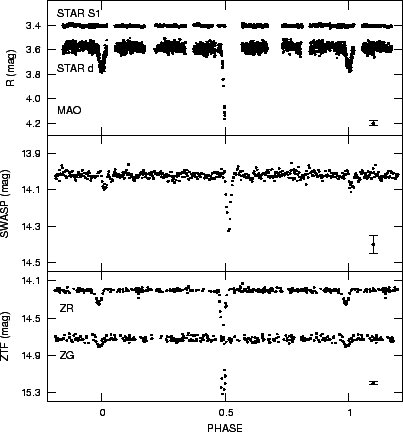 |
Fig. 2.
Phase-folded MAO (top), SWASP (middle),
and ZTF (bottom) light curves of the star 2MASS J02465266+412590
(the star a). The light curve of the star S1 was shifted by
|
In order to determine the orbital period, we applied the
dispersion spectrum analysis (Pelt et al. 1994, 1996) to these
4 nights; namely, we used the dispersion spectra ![]() ,
,
![]() , and
, and ![]() with
with
![]() . Then we
calculated average values of the statistics for the time intervals
between September 29, 2014 and August 15, 2015 and between
September 29, 2014 and November 13, 2015. We obtain
320.967
. Then we
calculated average values of the statistics for the time intervals
between September 29, 2014 and August 15, 2015 and between
September 29, 2014 and November 13, 2015. We obtain
320.967![]() 0.001 days and 410.101
0.001 days and 410.101![]() 0.003 days, respectively.
As the next step, we divided these time lags on integers because
we assume the integer number of the periods between the times of
minima. Finally, we estimated the period of
0.003 days, respectively.
As the next step, we divided these time lags on integers because
we assume the integer number of the periods between the times of
minima. Finally, we estimated the period of
![]() . This period is slightly shorter than
that from the ATLAS,
. This period is slightly shorter than
that from the ATLAS, ![]() : by 0
: by 0![]() 146. We used the
observational data from September 29, 2014 to determine the time
of minimum for the secondary eclipse because we have only a part
of the primary eclipse. As in Gaynullina et al. (2019), our
calculations of the time of minimum were performed in three
different ways: with the conjunction method (Duerbeck 1975), with
the 4th-order polynomial fit, and with the MINIMA27
code2that implements 6 different methods. The average of all values was
calculated with the standard deviation as the uncertainty. Thus we
obtained HJD(minII)
146. We used the
observational data from September 29, 2014 to determine the time
of minimum for the secondary eclipse because we have only a part
of the primary eclipse. As in Gaynullina et al. (2019), our
calculations of the time of minimum were performed in three
different ways: with the conjunction method (Duerbeck 1975), with
the 4th-order polynomial fit, and with the MINIMA27
code2that implements 6 different methods. The average of all values was
calculated with the standard deviation as the uncertainty. Thus we
obtained HJD(minII)
![]() .
.
The star a was observed in the SuperWASP Survey (SWASP,
Butters et al. 2010) from July 2004 till December 2007 and in the
ZTF Survey from July 2018 till November 2021. We have cleaned the
SWASP light curves removing those data points where internal
magnitude uncertainties exceeded
![]() . In Fig. 2, we show the
MAO, SWASP, and ZTF phase light curves folded with the period of
5.944 days using the earlier determined HJD(minII) as the initial
epoch. We used 33 more nights of MAO observations without signs of
eclipses and also plotted the folded light curve of the check star
S1. SWASP data are much noisier, therefore we present them
averaged in bins, with 500 bins used. The SWASP and ZTF phase
light curves show small offsets from phases 0 and 0.5. This means
that we need more observations of eclipses to obtain a more
precise ephemeris. From the MAO data, the other parameters for the
secondary eclipse are: depth,
. In Fig. 2, we show the
MAO, SWASP, and ZTF phase light curves folded with the period of
5.944 days using the earlier determined HJD(minII) as the initial
epoch. We used 33 more nights of MAO observations without signs of
eclipses and also plotted the folded light curve of the check star
S1. SWASP data are much noisier, therefore we present them
averaged in bins, with 500 bins used. The SWASP and ZTF phase
light curves show small offsets from phases 0 and 0.5. This means
that we need more observations of eclipses to obtain a more
precise ephemeris. From the MAO data, the other parameters for the
secondary eclipse are: depth,
![]() (in
(in ![]() );
duration,
);
duration,
![]() . The depth of the primary
eclipse is at least
. The depth of the primary
eclipse is at least
![]() , and it lasts about 0
, and it lasts about 0![]() 23. More
information about star a (and other studied stars) is given
in Table 3.
23. More
information about star a (and other studied stars) is given
in Table 3.
3.1.2. The star b: TYC 2853-60-1 or 2MASS 02461044+4123154?
The star TYC 2853-60-1, hereafter the star b1
(
![]() , J2000), is also a member of the open star cluster NGC 1039.
According to Maíz Apellániz et al. (2023), its VARF is
"marginal". The TESS publicly available light curve of the star
b1 shows very shallow and low-amplitude periodic changes.
The frequency analysis was performed with FAMIAS (Zima 2008), the
obtained period is
, J2000), is also a member of the open star cluster NGC 1039.
According to Maíz Apellániz et al. (2023), its VARF is
"marginal". The TESS publicly available light curve of the star
b1 shows very shallow and low-amplitude periodic changes.
The frequency analysis was performed with FAMIAS (Zima 2008), the
obtained period is
![]() . The folded light
curve demonstrates a detached binary star with two eclipses, where
the secondary eclipse shows up only slightly.
. The folded light
curve demonstrates a detached binary star with two eclipses, where
the secondary eclipse shows up only slightly.
In Fig. 3, we show the phased light curve of the star folded with
the period of 1.794 days as well as the smoothed curve. The
initial epoch was BJD
![]() .
.
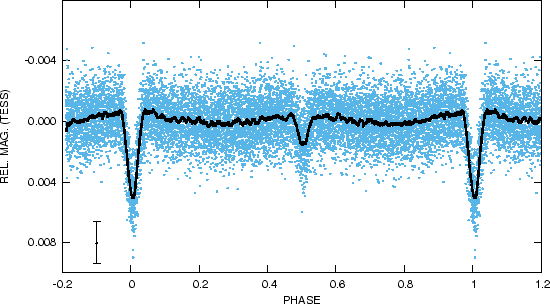 |
Fig. 3.
The TESS light curve of TYC 2853-60-1
(star b1) folded with the period of 1 |
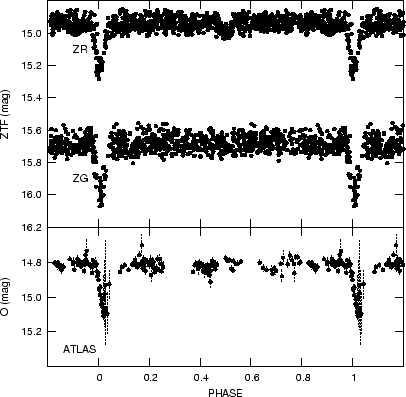 |
Fig. 4. The phased light curves of the star 2MASS 02461044+4123154 (the star b) calculated from ATLAS and ZTF data. |
We performed binary star modeling with JKTEBOP (Southworth et al.
2004). The final best model implies a strong third light
![]() (
(![]() ). Since the star b1 is not
included in the photometric catalogs of suspected variable stars,
we came to the conclusion that another star could be variable
because of a relatively large aperture radius of
). Since the star b1 is not
included in the photometric catalogs of suspected variable stars,
we came to the conclusion that another star could be variable
because of a relatively large aperture radius of
![]() .
Indeed, according to the ATLAS catalog, the star
2MASS 02461044+4123154, or star b
(
.
Indeed, according to the ATLAS catalog, the star
2MASS 02461044+4123154, or star b
(
![]() ,
J2000), has
,
J2000), has
![]() and
and
![]() ("dubious" classification). A half of
("dubious" classification). A half of ![]() is 1
is 1![]() 76647, which is close to our determined period.
According to Maíz Apellániz et al. (2023), this star's VARF
is "variable". Figure 4 shows the light curves from the ATLAS
and ZTF surveys folded with the period
76647, which is close to our determined period.
According to Maíz Apellániz et al. (2023), this star's VARF
is "variable". Figure 4 shows the light curves from the ATLAS
and ZTF surveys folded with the period
![]() and epoch
BJD
and epoch
BJD
![]() , calculated with JKTEBOP from TESS data. Now
the depth of the minimum during the primary eclipse is about
, calculated with JKTEBOP from TESS data. Now
the depth of the minimum during the primary eclipse is about
![]() , which is two orders of magnitude larger than that in the
TESS data for the star b1. The considerable difference in
the depths of the primary and secondary minima,
, which is two orders of magnitude larger than that in the
TESS data for the star b1. The considerable difference in
the depths of the primary and secondary minima,
![]() (
(![]() ) and
) and
![]() (
(![]() ), compared to
), compared to
![]() (
(![]() )
and
)
and
![]() (
(![]() ), implies that the second star is much
cooler.
), implies that the second star is much
cooler.
In Table 2, columns 2 and 3, we present the times of the primary
minimum derived from the TESS light curve of the star b1.
For this purpose, we used (a) Gauss function fitting
(lmfit3,
Levenberg-Marquardt minimizer) and (b) MINIMA27 code. For the
calculation of the new linear elements (BJD![]() and
and ![]() ), we used
only those minima that included enough data points around minima
without large gaps. As a result, 12 times of the primary minimum
were used. The ephemeris determined by the least-squares solution
is:
), we used
only those minima that included enough data points around minima
without large gaps. As a result, 12 times of the primary minimum
were used. The ephemeris determined by the least-squares solution
is:
The fourth column in Table 2 contains O-C values averaged for the two methods and calculated using these linear elements.
O-C values that show only weak signs of variation on the time scale about 20 days. Eclipse timing variations can have different nature, for example, the presence of an additional body in the system. To date, the shortest period for an exoplanet around the binary star (P-type system) is 43 days, and seven exoplanet candidates have possible periods shorter than 20 days. The third body model fit was performed with the OCFit software (Parimucha et al. 2018), the package for fitting O-C diagrams using Genetic Algorithms, and Markov chain Monte Carlo methods. The results are also shown in Fig. 5. We do not provide values for the model parameters because there is insufficient data to be confident. In order to verify periodic O-C changes, TESS light curves for the star b are needed.
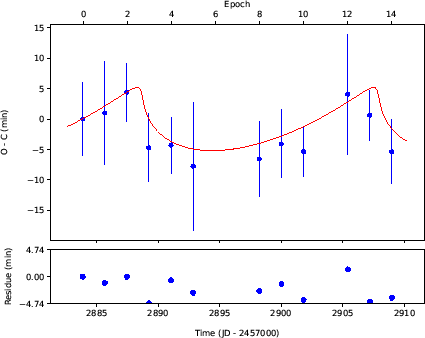 |
Fig. 5.
O-C values (see Table 2) for the star
b and the possible third-body model fit with period
|
| O-C | |||
| Gauss fitting | Minima27 | ||
| 0 | 2883.875 (0.003) | 2883.877 (0.002) | 0.0000 (0.0042) |
| 1 | 2885.670 (0.003) | 2885.672 (0.005) | 0.0007 (0.0059) |
| 2 | 2887.468 (0.003) | 2887.469 (0.002) | 0.0030 (0.0033) |
| 3 | 2889.256 (0.004) | 2889.258 (0.002) | -0.0033 (0.0039) |
| 4 | 2891.051 (0.003) | 2891.053 (0.001) | -0.0030 (0.0032) |
| 5 | 2892.843 (0.004) | 2892.846 (0.006) | -0.0054 (0.0070) |
| 8 | 2898.230 (0.003) | 2898.229 (0.003) | -0.0046 (0.0040) |
| 9 | 2900.027 (0.002) | 2900.026 (0.003) | -0.0028 (0.0039) |
| 10 | 2901.820 (0.002) | 2901.820 (0.002) | -0.0037 (0.0029) |
| 12 | 2905.415 (0.002) | 2905.417 (0.006) | 0.0028 (0.0068) |
| 13 | 2907.209 (0.002) | 2907.209 (0.001) | 0.0004 (0.0028) |
| 14 | 2909.000 (0.003) | 2908.999 (0.002) | -0.0037 (0.0036) |
3.1.3. The star c: 2MASS J02475840+4116103
The star c, or 2MASS J02475840+4116103
(
![]() ,
J2000), is located comparatively close to the Sun. According to
Maíz Apellániz et al. (2023), the star has the flag
VARF="variable".
The star c was included in the ZTF catalog of suspected
variables, and its suspected periods are
,
J2000), is located comparatively close to the Sun. According to
Maíz Apellániz et al. (2023), the star has the flag
VARF="variable".
The star c was included in the ZTF catalog of suspected
variables, and its suspected periods are
![]() and
and
![]() for the
for the ![]() and
and ![]() bands. The publicly
available TESS light curve (sector 58) of the star c shows
small-amplitude variations of the flux. We analyzed the TESS light
curve with FAMIAS. The Fourier spectrum presented in the top panel
of Fig. 6 shows only two significant frequencies with a ratio
bands. The publicly
available TESS light curve (sector 58) of the star c shows
small-amplitude variations of the flux. We analyzed the TESS light
curve with FAMIAS. The Fourier spectrum presented in the top panel
of Fig. 6 shows only two significant frequencies with a ratio
![]() =2, which is typical of binary stars. The light curve
folded with the period
=2, which is typical of binary stars. The light curve
folded with the period
![]() (that
agrees well with the ZTF estimate) is also shown in Fig. 6. The
phased light curve shows two minima, and the secondary one is much
shallower.
(that
agrees well with the ZTF estimate) is also shown in Fig. 6. The
phased light curve shows two minima, and the secondary one is much
shallower.
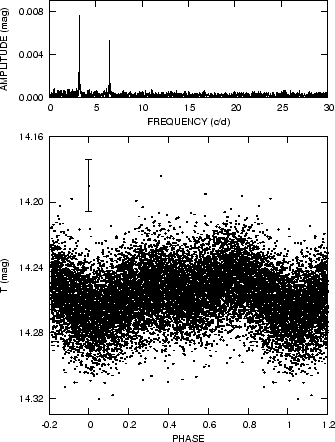 |
Fig. 6.
Top panel: Fourier spectrum for the star
c that shows only two frequencies. Bottom panel: TESS light
curve of the star 2MASS J02475840+4116103 (the star c)
folded with the period of 0 |
3.1.4. The star d: 2MASS J02464361+4120282
According to GAIA DR3 (Pourbaix et al. 2022), the star d
(
![]() ,
J2000) is a single-line spectroscopic binary with the period of
,
J2000) is a single-line spectroscopic binary with the period of
![]() days and eccentric orbit with
days and eccentric orbit with ![]() .
We analyzed its TESS light curve with FAMIAS and found that the
star showed small-amplitude (
.
We analyzed its TESS light curve with FAMIAS and found that the
star showed small-amplitude (
![]() -
-
![]() ) variability
with the period of
) variability
with the period of
![]() days. The normalized
light curve and the simple sinusoidal model are plotted in Fig. 7.
Thus, we find that the photometric period differs from the period
days. The normalized
light curve and the simple sinusoidal model are plotted in Fig. 7.
Thus, we find that the photometric period differs from the period
![]() of the spectroscopic binary.
of the spectroscopic binary.
Taking into account three quantities, namely the period,
amplitude, and spectral type, the star d can be a BY Dra
type variable of Class III (Chahal et al. 2022), and our measured
period corresponds to the rotation period of one of its
components. At the same time, the measurements of the H![]() line equivalent width (Zhang et al. 2020) did not show magnetic
activity or variability in this system, so more information is
needed for the star d.
line equivalent width (Zhang et al. 2020) did not show magnetic
activity or variability in this system, so more information is
needed for the star d.
3.1.5. The star e: 2MASS J02465622+4117392 or 2MASS J02465472+4118213?
In Maíz Apellániz et al. (2023), the star
2MASS J02465622+4117392 (the star e)
(
![]() ,
J2000) has the VARF parameter as "non-variable" or "marginal".
The TESS light curve shows very similar variability (but with
different trends in four time intervals) for two stars: the star
e and 2MASS J02465472+4118213 (the star e1). The
angular distance between these stars is
,
J2000) has the VARF parameter as "non-variable" or "marginal".
The TESS light curve shows very similar variability (but with
different trends in four time intervals) for two stars: the star
e and 2MASS J02465472+4118213 (the star e1). The
angular distance between these stars is
![]() . The radii of
the best photometric apertures for the stars e and
e1 are
. The radii of
the best photometric apertures for the stars e and
e1 are
![]() and
and
![]() , so both apertures contain
both stars. After aligning, the light curve of the star e
shows that its variability is slightly larger than for the star
e1. That is why we guess that our variable is the star
e. The analysis with FAMIAS gave us 4 frequencies and the
main one, with the largest amplitude, is
, so both apertures contain
both stars. After aligning, the light curve of the star e
shows that its variability is slightly larger than for the star
e1. That is why we guess that our variable is the star
e. The analysis with FAMIAS gave us 4 frequencies and the
main one, with the largest amplitude, is
![]() c d
c d![]() , the corresponding period being
, the corresponding period being
![]() days. The other frequencies are
days. The other frequencies are
![]() c d
c d![]() ,
,
![]() c d
c d![]() ,
and
,
and
![]() c d
c d![]() . Figure 8 shows the TESS light
curve with the synthetic model using 4 frequencies and the phased
light curve. Taking into account the star's period, amplitude, and
spectral classification. we conclude that this star is probably an
ellipsoidal binary.
. Figure 8 shows the TESS light
curve with the synthetic model using 4 frequencies and the phased
light curve. Taking into account the star's period, amplitude, and
spectral classification. we conclude that this star is probably an
ellipsoidal binary.
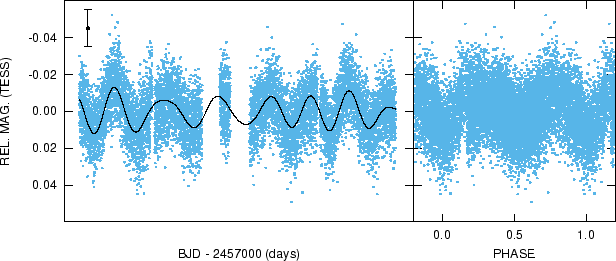 |
Fig. 8. TESS light curve of the star 2MASS J02465622+4117392 (the star e) with the synthetic model (left panel) and the phase light curve folded with the period 4.022 days (right panel). |
3.2. The field of CV Boo
3.2.1. The star f: 2MASS J15273711+3703070
After cross-identification of the stars in the CV Boo field with
ATLAS and ZTF catalogs of suspected variable stars, the star
f (
![]() , J2000) that is contained in both
catalogs has been analyzed. The analysis of the MAO light curves
confirmed the star's variability. Typical uncertainties of the
instrumental magnitudes for the new variable star,
, J2000) that is contained in both
catalogs has been analyzed. The analysis of the MAO light curves
confirmed the star's variability. Typical uncertainties of the
instrumental magnitudes for the new variable star,
![]() , are large enough because of its low
brightness relative to the reference star, with formal photometric
error
, are large enough because of its low
brightness relative to the reference star, with formal photometric
error
![]() , which is why we do not show the
uncertainties in the left panel of Fig. 9. The ZTF catalog gives
the possible periods of 925
, which is why we do not show the
uncertainties in the left panel of Fig. 9. The ZTF catalog gives
the possible periods of 925![]() 45242 and 933
45242 and 933![]() 15749, the ATLAS
catalog gives the periods of
15749, the ATLAS
catalog gives the periods of
![]() ,
,
![]() , and
, and
![]() , with "dubious"
classification.
, with "dubious"
classification.
Unfortunately, the light curves available in ATLAS, ZTF, and SWASP
surveys have data that are insufficient for proper analysis. That
is why, despite the noisy light curve, the frequency analysis of
the star f with FAMIAS was done using the MAO dataset.
Three frequencies exceed the level of significance of ![]() ,
namely 6.0467 c
,
namely 6.0467 c ![]() , 3.0019 c
, 3.0019 c ![]() , and 3.01925
c
, and 3.01925
c ![]() . The ratios are
. The ratios are ![]() and
and ![]() ,
which indicates a binary star. The corresponding period is
,
which indicates a binary star. The corresponding period is
![]() . In Fig. 9 (left panel), we plotted
the normalized and smoothed MAO phased light curves of the
variable and comparison stars folded with this period. Taking into
account the spectral type, period, and low amplitude, we conclude
that this is an ellipsoidal binary star exhibiting the O'Connell
effect (O'Connell 1951). The ATLAS light curve folded with the
same period and initial epoch as for MAO data is shown in the
right panel of Fig. 9. The ZTF light curve is noisier but shows a
distinct difference in the depth of the secondary minimum. An
assumption about the binary nature of this star is supported by
its inclusion in the list of new binary and variable star
candidates detected by LAMOST (Qian et al. 2019) because of radial
velocity difference of
. In Fig. 9 (left panel), we plotted
the normalized and smoothed MAO phased light curves of the
variable and comparison stars folded with this period. Taking into
account the spectral type, period, and low amplitude, we conclude
that this is an ellipsoidal binary star exhibiting the O'Connell
effect (O'Connell 1951). The ATLAS light curve folded with the
same period and initial epoch as for MAO data is shown in the
right panel of Fig. 9. The ZTF light curve is noisier but shows a
distinct difference in the depth of the secondary minimum. An
assumption about the binary nature of this star is supported by
its inclusion in the list of new binary and variable star
candidates detected by LAMOST (Qian et al. 2019) because of radial
velocity difference of
![]() km s
km s![]() . At the
same time, the object was classified as an RS CVn star in GAIA DR3
(Maíz Apellániz et al. 2023) catalog, but without
supporting information like the period.
. At the
same time, the object was classified as an RS CVn star in GAIA DR3
(Maíz Apellániz et al. 2023) catalog, but without
supporting information like the period.
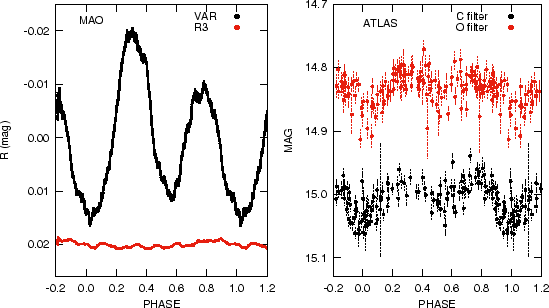 |
Fig. 9.
Left panel: the smoothed normalized phase
MAO light curves of the variable star f and comparison
star. The light curve of the star R3 was shifted by
|
4. Discussion and Conclusions
The archives of monitoring observations of two eclipsing binary stars obtained at Mt. Maidanak observatory were studied to search for new variable stars and in order to determine their variability types. The stars in the fields were cross-matched with the catalogs of suspected variable stars; publicly available light curves from the TESS mission and other surveys were studied. In Table 3, we present some observational and physical characteristics of the studied stars from the literature. The information in columns 2-4 is taken from GAIA DR3 or TESS Input Catalog (Stassun et al. 2019), the photometric magnitudes and colors in columns 6 and 7 are from the AAVSO Photometric All Sky Survey or ASCC-2.5 (Kharchenko 2001).
| Star | ||||||
| (K) | (R |
(M |
(pc) | (mag) | (mag) | |
| a | 5435.5 | 1.39 | 0.94 | 966 | ||
| b | 4669.9 | 0.96 | 642 | 15.28 | 0.92 | |
| c | 3329.8 | 0.35 | 0.34 | 99 | ||
| d | 5728.1 | 1.02 | 1.04 | 345 | 12.63 | 0.70 |
| e | 5696.4 | 1.56 | 0.98 | 808 | 13.87 | 0.74 |
| f | 5656.1 | 1.48 | 1.01 | 1298 | 14.95 | 0.66 |
In Fig. 10, we show the locations of studied stars in the color-magnitude diagram. All six stars are main-sequence dwarfs, four of them have spectral types G2-G8, and two others have K3 and M3-M4 types. Such locations, combined with other characteristics, show that the nature of the brightness variability is not pulsations. The final result of our analysis is as follows.
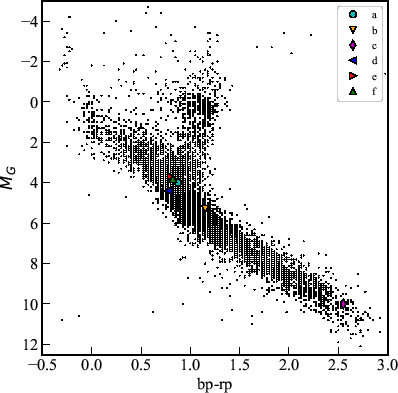 |
Fig. 10.
Extinction-corrected color-magnitude
diagram, with the stars studied in this work marked. The grey
points are 100000 randomly selected stars from GAIA DR3 (with
high-quality parallaxes:
|
2MASS J02465266+4125290 is a detached eclipsing binary star with
the period of
![]() . The depths of minimum I
and minimum II are at least
. The depths of minimum I
and minimum II are at least
![]() and
and
![]() in Bessel
in Bessel ![]() filter.
filter.
2MASS 02461044+4123154 is a detached eclipsing binary star with
![]() . The depth of the primary minimum is
about
. The depth of the primary minimum is
about
![]() (ZTF
(ZTF ![]() filter).
filter).
2MASS J02475840+4116103 is an ellipsoidal binary star.
![]() , depths of minima are less than
, depths of minima are less than
![]() .
.
2MASS J02464361+4120282 is a spectroscopic binary containing a
variable star of the BY Dra type with the rotation period of
![]() . The variability amplitude is less than
. The variability amplitude is less than
![]() .
.
2MASS J02465622+4117392 is an ellipsoidal binary star.
![]() , the amplitude is less than
, the amplitude is less than
![]() .
.
2MASS J15273711+3703070 is an ellipsoidal and/or RS CVn binary
system (perhaps an ellipsoidal binary system with one or two
active components).
![]() , the amplitude is
at least
, the amplitude is
at least
![]() .
.
Acknowledgements. This research has made use of the SIMBAD
database, operated at CDS, Strasbourg, France. This research has
made use of the VizieR catalog access tool, CDS, Strasbourg,
France. The original description of the VizieR service was
published in Ochsenbein et al. (2000). This work has made use of
data from the European Space Agency (ESA) mission
Gaia4, processed by the
Gaia Data Processing and Analysis Consortium
(DPAC5).
Funding for the DPAC has been provided by national institutions,
in particular, the institutions participating in the Gaia
Multilateral Agreement. This paper includes data collected with
the TESS mission, obtained from the Mikulski Archive for Space
Telescopes (MAST) at the Space Telescope Science Institute
(STScI). Funding for the TESS mission is provided by the NASA
Explorer Program. STScI is operated by the Association of
Universities for Research in Astronomy, Inc., under NASA contract
NAS 5B€“26555. Support for MAST for non-HST data is provided by
the NASA Office of Space Science via grant NNX13AC07G and by other
grants and contracts. We thank the observers O. Parmonov,
O. Abdullaev, and T. Boyqobilov.
References:
Bogomazov, A. I., Ibrahimov, M. A., Satovskii, B. L., et al. 2016a, Astrophysics & Space Science, 361, article id. 4
Bogomazov, A. I., Kozyreva, V. S., Satovskii, B. L., et al. 2016b, Astrophysics & Space Science, 361, article id. 390
Butters, O. W., West, R. G., Anderson, D. R., et al. 2010, Astron. & Astrophys., 520, article id. L10
Cantat-Gaudin, T., Vallenari, A., Sordo, R., et al. 2018, Astron. & Astrophys., 615, article id. A49
Chahal, D., de Grijs, R., Kamath, D., & Chen, X. 2022, Monthly Notices Roy. Astron. Soc., 514, No. 4, 4932
Chen, X., Wang, S., Deng, L., et al. 2020 Astrophys. J., Suppl. Ser., 249, article id. 18
Duerbeck, H. W. 1975, Acta Astronomica, 25, No. 4, 361
Gaia Collaboration, Brown, A. G. A., Vallenari, A., Prusti, T., et al. 2021 Astron. & Astrophys., 649, article id. A1
Gaynullina, E. R., Khalikova, A. V., Serebryanskiy, A. V., et al. 2019, Open European Journal on Variable Stars, 202, 1
Heinze, A. N., Tonry, J. L., Denneau, L., et al. 2018, Astron. J., 156, article id. 241
Henden, A. A., Levine, S., Terrell, D., & Welch, D. L. 2015, American Astronomical Society, AAS Meeting, 225, id. 336.16
Khalikova, A., Gaynullina, E., & Serebryanskiy, A. 2022, New Astronomy, 97, article id. 101875
Kharchenko, N. V. 2001 Kinematika i Fizika Nebesnykh Tel, 17, No. 5, 409
Maíz Apellániz, J., Holgado, G., Pantaleoni González, M., & Caballero, J. A. 2023, Astron. & Astrophys., 677, article id. A137
O'Connell, D. J. K. 1951, Monthly Notices Roy. Astron. Soc., 111, No. 6, 642
Ochsenbein, F., Bauer, P., & Marcout, J. 2000, Astron. & Astrophys., Suppl. Ser., 143, No. 1, 32
Parimucha, Š., Gajdoš, P., Kudak, V., et al. 2018, Research in Astron. & Astrophys., 18, No. 4, article id. 047
Pelt, J., Hoff, W., Kayser, R., et al. 1994, Astron. & Astroph., 286, No. 3, 775
Pelt, J., Kayser, R., Schild, R., & Thomson, D. J. 1996, Proceedings of the IAU Symposium 168, eds. M. C. Kafatos & Y. Kondo, p. 539
Pourbaix, D., Arenou, F., Gavras, P., et al. 2022, Gaia DR3 documentation, European Space Agency; Gaia Data Processing and Analysis Consortium. Online at https://gea.esac.esa.int/archive/documentation/GDR3/index.html, id. 7
Qian, S.-B., Shi, X.-D., Zhu, L.-Y., et al. 2019, Research in Astron. & Astrophys., 19, No. 5, article id. 064
Southworth, J., Maxted, P. F. L., & Smalley, B. 2004, Monthly Notices Roy. Astron. Soc., 351, No. 4, 1277
Stassun, K.G., Oelkers, R. J., Paegert, M., et al. 2019, Astron. J., 158, article id. 138
Tutukov, A. V. & Bogomazov, A. I. 2012, Astronomy Reports, 56, No. 10, 775
Zhang, L.-Y., Long, L., Shi, J., et al. 2020, Monthly Notices Roy. Astron. Soc., 495, No. 1, 1252
Zima, W. 2008, Communications in Asteroseismology, 157, 387
